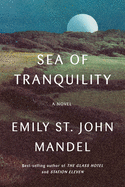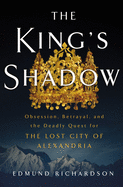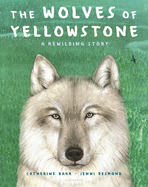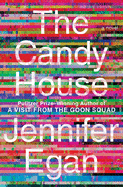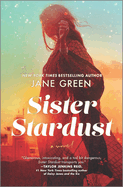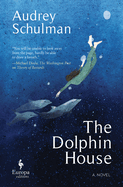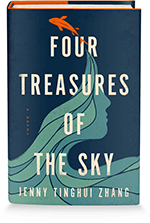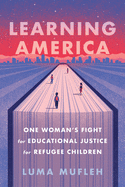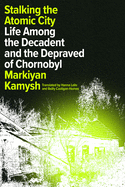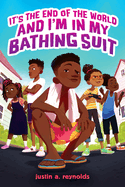Week of Tuesday, April 5, 2022
Spring is (finally) upon us. And, as plants grow, so, too, do the babies.
 In Amika Kroll and Ebony Glenn's Strut, Baby, Strut (Little Simon, $8.99), three girls grow from scooting babies to strutting women. The three girls learn from the women raising them to "lean toward tomorrow" and "reach high... for all your dreams." Kroll's upbeat text urges the girls on as they walk, stumble, run and grow; Glenn's boldly colored and thickly outlined art matches Kroll's exuberance.
In Amika Kroll and Ebony Glenn's Strut, Baby, Strut (Little Simon, $8.99), three girls grow from scooting babies to strutting women. The three girls learn from the women raising them to "lean toward tomorrow" and "reach high... for all your dreams." Kroll's upbeat text urges the girls on as they walk, stumble, run and grow; Glenn's boldly colored and thickly outlined art matches Kroll's exuberance.
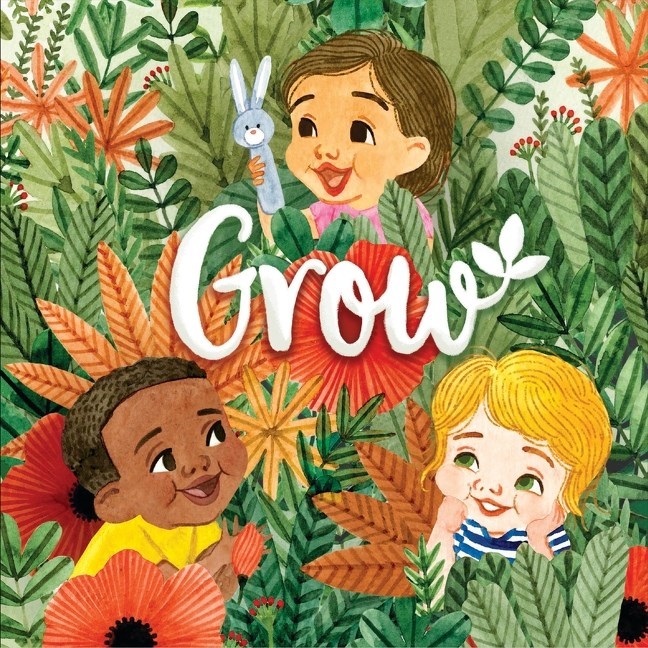 Grow (Clarion, $10.99) begins with the text, "I wanted for you, like a sprout from a seed," and an illustration of a pregnant woman in a lush garden. Closer inspection shows that, instead of plants, the garden is brimming with plant and tree-sized leaves. At the top of the right-hand page, a pull-tab reveals a green leaf. The page turn shows more abundance; another tab reveals a red leaf: "You were tiny and fragile, but grew like a weed./ Every day a new leaf, light and love make you grow." Theodore Henry and Hsulynn Pang's board book is a perfect title for caretakers to share with their little loved ones.
Grow (Clarion, $10.99) begins with the text, "I wanted for you, like a sprout from a seed," and an illustration of a pregnant woman in a lush garden. Closer inspection shows that, instead of plants, the garden is brimming with plant and tree-sized leaves. At the top of the right-hand page, a pull-tab reveals a green leaf. The page turn shows more abundance; another tab reveals a red leaf: "You were tiny and fragile, but grew like a weed./ Every day a new leaf, light and love make you grow." Theodore Henry and Hsulynn Pang's board book is a perfect title for caretakers to share with their little loved ones.
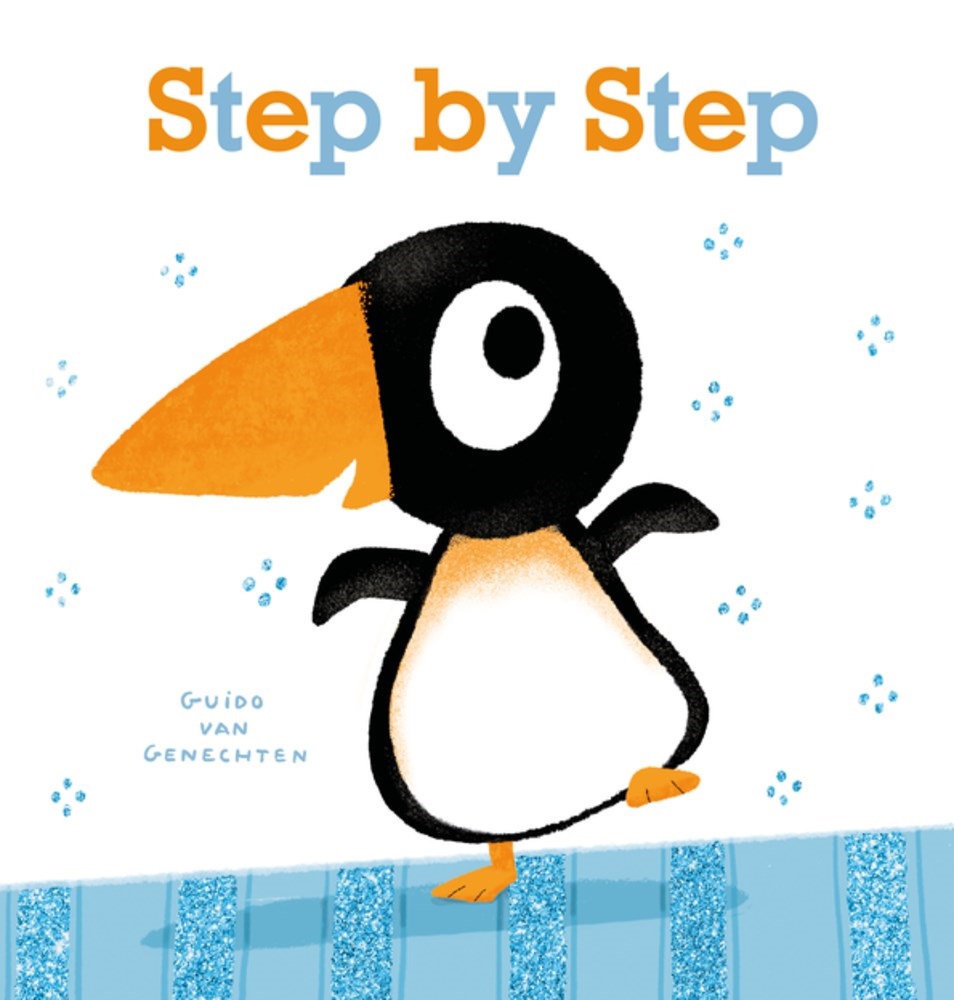 Guido Van Genechten uses adorable baby animals to show children ages one to three the process of learning to walk in Step by Step (Clavis, $12.95): "If you want to learn how to walk, you will first have to learn how to get up." Little Mouse and Kitty struggle to get on their feet; Little Elephant balances on their trunk; Piglet "uses the sofa to help him get up." Soft colors and cute animals make this "how-to" board book a gentle reminder that "you must learn to stand up, fall down, and stand up again." --Siân Gaetano, children's and YA editor, Shelf Awareness
Guido Van Genechten uses adorable baby animals to show children ages one to three the process of learning to walk in Step by Step (Clavis, $12.95): "If you want to learn how to walk, you will first have to learn how to get up." Little Mouse and Kitty struggle to get on their feet; Little Elephant balances on their trunk; Piglet "uses the sofa to help him get up." Soft colors and cute animals make this "how-to" board book a gentle reminder that "you must learn to stand up, fall down, and stand up again." --Siân Gaetano, children's and YA editor, Shelf Awareness
The Candy House
by Jennifer Egan
Jennifer Egan (Manhattan Beach) returns to the stylistic brio and edgy substance of her Pulitzer Prize-winning novel A Visit from the Goon Squad. The Candy House revives many of the characters of its literary soulmate while using them to explore a set of fresh and compelling themes.
In chapters that function both as discrete stories and devices that subtly link the lives of a handful of recurring characters, The Candy House ranges over more than seven decades, beginning in the mid-1960s. Egan conjures an unsettling but clearly plausible next stage of social media, where Internet visionary Bix Bouton invents a "memory externalization device" he calls the Mandala Cube, which allows individuals to upload and store a lifetime of memories in mere hours. If they choose, they can share those recollections with the "Collective Consciousness," granting them "proportionate access to the anonymous thoughts and memories of everyone in the world, living or dead, who had done the same." But as Egan recognizes, "knowing everything is too much like knowing nothing; without a story it's all just information." As she travels forward and backward in time, her stories reveal what is lost in the embrace of this new technology.
The Candy House holds a mirror up to contemporary society while simultaneously casting a skeptical eye on a future that may already be here. Readers who delighted in the ingenuity of A Visit from the Goon Squad will luxuriate in this novel's Easter eggs, making the urge to reread it immediately almost irresistible. While its sensibility is coolly observant, at its center is a warm, strongly beating heart. --Harvey Freedenberg, freelance reviewer
Discover: Jennifer Egan paints an unsettling portrait of life in a near future in which the sharing of consciousness becomes possible.
Sister Stardust
by Jane Green
Sister Stardust is the captivating coming-of-age story of a shop girl from Dorset swept into 1960s Marrakech among the rich and famous. Jane Green (Summer Secrets; The Sunshine Sisters) dazzles readers with the brilliant adventures of Claire, who leaves behind a little Dorset village and a troubled relationship with her stepmother to journey to London. From there she is astonished to achieve a few girlhood dreams: losing baby fat, working in progressively hipper clothing stores and buying cooler clothes, finally meeting real, live rock stars and setting off on a spur-of-the-moment trip that will change her life forever.
This story takes the form of an extended flashback, as an elderly, widowed Claire goes through boxes in the attic and finally tells her daughter, Tally, what the colorful Moroccan artifacts remind her of. Still in her teens, Claire had jumped into a silver Bentley and been flown away to Marrakech, where she became the houseguest of 1960s icons Paul and Talitha Getty (true historical figures), running with a large group of famous musicians (of the fictional hit band the Wide-Eyed Boys) and an enigmatic chauffeur/bodyguard named Jimmy. However, a tragedy will change Claire's course once again.
This dreamy narrative emphasizes life lessons and revels in the glitter and dazzle of 1960s free love and sex in more or less equal measure. Sister Stardust gathers momentum and achieves the kind of propulsive prose that brings immediacy to its joys and sorrows. Female friendships, the arts and the sensory joys of Morocco combine for a sparkling coming-of-age story of simple adventure and profound experiences. --Julia Kastner, librarian and blogger at pagesofjulia
Discover: In this captivating coming-of-age novel, a teenager from the English countryside throws herself into life in 1960s Marrakech in a grand adventure that will color the rest of her life.
School Days
by Jonathan Galassi
Small wonder so many novels are set at prep schools. As Sam Brandt, graduate of Connecticut's prestigious Leverett School and longtime Leverett English teacher, puts it in School Days, "It was human nature, wasn't it? Put warm bodies together in a sealed environment... and unnaturally intense attachments were bound to form." Jonathan Galassi's short but engulfing novel is about such attachments, and particularly about the point when these attachments begin to reflect not steadfastness so much as stagnation.
School Days opens in October 2007 with the adult-directed equivalent of a note from the principal's office: Leverett's headmaster, Boris Krohn, has summoned Sam to discuss an unfortunate development. Ron Bryden, a former Leverett student who would have graduated with Sam and the class of '67 if Ron hadn't dropped out, has written to Boris requesting "a few amends" for the abuse perpetrated on him by "one of your star pedagogues, the ones you're always touting as embodying what makes a Leverett education so unique." A problem for Leverett becomes a problem for Sam when Boris asks him to do some digging into Ron's experience at the school, including his reason for leaving after two years.
Galassi (Muse) crafts supple sentences with atavistic touches; young Sam "was the chump who actually believed the poems and pop songs and old nostrums." As for older Sam, readers may be moved to wonder if by staying true to Leverett, he wasn't so much affirming his past as guaranteeing that he would never have to grow up and face the possibility that love was, as a classmate once defined it, "no more or no less than unrequited lust." --Nell Beram, author and freelance writer
Discover: In this big-impact little novel, a prep school graduate turned faculty member is asked to investigate a former classmate's allegation of abuse by a charismatic former teacher.
The Dolphin House
by Audrey Schulman
A young, mostly deaf woman becomes part of a research project in the mid-1960s in this compelling novel that explores human and dolphin social bonds and communication.
The Dolphin House by Audrey Schulman (Three Weeks in December) draws its inspiration from an experiment that took place in 1965. Cora is working as a waitress at a dockside restaurant on St. Thomas in the U.S. Virgin Islands when, on a walk, she comes across four dolphins held in a lagoon. A scientist there asks Cora to keep notes while he steps away. The head of the project, Dr. Blum, is impressed with her observational skills and offers her a job. As Cora bonds with the dolphins, she takes on the role of their advocate and protector, eventually embarking on an ambitious project in which she lives with a dolphin named Junior in an attempt to teach him human speech.
Schulman's signature blend of science and literary fiction is on full display as Cora studies two different sets of minds, the dolphins' and the male scientists', all of whom to varying degrees view her as separate from their world. At best, they assume women are innately suited to teach language as part of a maternal instinct; at worst, she is treated as a novelty or a sex object. Readers will admire and feel for Cora as she uses her growing expertise--and her own experience analyzing different types of communication--in a quest to carve out some security for the dolphins and for herself. --Kristen Allen-Vogel, information services librarian at Dayton Metro Library
Discover: This thought-provoking novel, based on real events, probes communication between species and between sexes.
Four Treasures of the Sky
by Jenny Tinghui Zhang
Jenny Tinghui Zhang's breathtaking debut novel, Four Treasures of the Sky, opens like a traditional hero's journey, something that might need multiple sequels to encompass the breadth and ambition of its saga. But the story is pared down to its essence and thus reads more like poetry, subtle but effective, taut without sacrificing immersion. This continent-hopping coming-of-age story set in the late 1800s follows young Daiyu, named after the fictional poet Lin Daiyu of Chinese literature. Our protagonist despises this name for the curse she feels it puts upon her: a life doomed to sadness and frailty. At home in China, in the comfort and familiarity of her fishing village, Daiyu vows she will shed the melancholy of Lin Daiyu's legacy.
When her parents disappear one night for reasons Daiyu can't understand--she later learns they were arrested--she's shipped away to Zhifu by her grandmother for her own safety. Far from her beloved village and desperate for any kind of work, Daiyu clings to the gift her family gave her: she is skilled with her hands. In Zhifu, she assumes the name and appearance of a boy named Feng, who sweeps the stones outside a school and learns traditional Chinese calligraphy under the imaginative, dreamlike tutelage of a man known only as Master Wang. But the dream cannot last, as readers know from the very first paragraph: "When I am kidnapped, it does not happen in an alleyway. It does not happen in the middle of the night. It does not happen when I am alone."
After following a mysterious but magnetic man in pursuit of a noodle shop, Daiyu suddenly awakes in darkness. In that darkness, she's taught English by an unknown woman, and gradually Daiyu understands that Zhifu is gone, China itself is gone, her very self is to be banished. She is going to America, though for what purpose she doesn't initially grasp. Soon, though, the truth becomes obvious: she might bear the name of a boy, but she has the body of a girl, and she'll be expected to use it.
In a San Francisco brothel run under the guise of a laundromat, her name transforms again, as does her identity. Daiyu turns into Peony, and she loses something of herself in the process. But even in the sickening monotony of her daily work, and in the trauma that suffocates the girls around her, Daiyu clings to the hope she first manifested in Zhifu. Somehow, there will be escape. There will be beauty. Only when she meets a Chinese boy named Samuel does the promise of a real life appear before her, and with it a trip deeper into the American West, into a world she has no concept of: Idaho, a land without an ocean. Her name shapeshifts yet again. "Daiyu to Feng to Peony to Jacob Li," Daiyu narrates. "When will I be me again? And if I become me again, will I know who she is?"
As the Chinese Exclusion Act warps America--during the era of this book and deep into our present reality--Daiyu is forced to protect herself by burrowing further into the identity and physicality of Jacob Li. She loses her body but retains the spirit she first unfurled in Zhifu. She knows how to survive, even how to capture the beauty around her, so long as she believes home is her final destination.
It is this hope in the face of crushing tragedy that makes Four Treasures of the Sky such a triumph. Unlike the character she is named for, Daiyu is not melancholic, though her life is defined by atrocities that should prompt such sadness. She is introspective and damaged, yes, but a spark remains in the pit of her chest, a sacred thing both childlike in its innocence and mature in its power.
Zhang has admitted that she fretted over being able to capture the voice of a 13-year-old girl, yet there was never any reason for such worry. As a narrator, Daiyu speaks with remarkable clarity, an intelligence that never undermines or counteracts her youth. This intelligence is perhaps best exemplified when she recognizes the stares of the white Americans around her: "My body is covered in the syllables of another language, the scroll of a kingdom that has existed long before they did and will continue existing long after they are gone. I am something they cannot fathom. I am something they fear. We all are."
Throughout the book, Lin Daiyu serves as a sort of ghost, hovering beside Daiyu and occasionally speaking to her--sometimes taunting, sometimes guiding. The result is a story that combines the tragic with the beatific, the historic with the folkloric. Zhang blurs these lines with such grace that the book reads easily, in spite of its heavy material. But it is the final few paragraphs that will stick between the ribs of any devoted reader. Zhang has accomplished a remarkable work of fiction that feels so real it stings. --Lauren Puckett
Science Fiction & Fantasy
Sea of Tranquility
by Emily St. John Mandel
Emily St. John Mandel's sixth novel, Sea of Tranquility--a dazzling philosophical mystery about mental health and human connection--links early 20th-century Canada, contemporary Manhattan and future moon colonies. Gaspery-Jacques Roberts grew up in Night City on the moon's Colony Two. In 2401, the Time Institute hires him to investigate a recurring blip in time, one experienced in a Vancouver Island forest by Edwin, an English immigrant to Canada in the 1910s, and by Vincent, a teenage girl filming there in the 1990s. Gaspery spots the same anomaly, which occurs while a violinist is playing, at the Oklahoma City Airship Terminal in the year 2172. It's a scene that's key to Night City novelist Olive Llewellyn's Marienbad.
Fans of Mandel's The Glass Hotel will recognize some characters, and those familiar with Station Eleven will find similarities in the pandemic plot of Marienbad. This novel, however, stands alone. It surges forward in time and then works its way back, using date headings as cues. Mandel keeps "the anomaly" nebulous, layering the stories in intriguing ways. The "Last Book Tour on Earth" segments, set just as a pandemic hits, resonate with the Covid-19 experience.
"We knew it was coming," Llewellyn's novel notes with prescience. As Gaspery visits the pivotal dates to scrutinize the glitch, he hopes that with hindsight he can change--for the better--the results of the storylines. Mandel's depth of characterization and breadth of social commentary will, once again, attract those who don't normally read sci-fi. How does she do it? One intricate, compulsively readable hit after another. --Rebecca Foster, freelance reviewer, proofreader and blogger at Bookish Beck
Discover: Emily St. John Mandel's dazzlingly intricate novel blends historical fiction, up-to-the-minute commentary and science-fiction predictions.
Biography & Memoir
Warming Up Julia Child: The Remarkable Figures Who Shaped a Legend
by Helen Lefkowitz Horowitz
American home-cooking maverick Julia Child knew she had arrived when she made the cover of Time magazine in 1966, but Helen Lefkowitz Horowitz considers the accompanying article incomplete. In the ebullient Warming Up Julia Child: The Remarkable Figures Who Shaped a Legend, Horowitz spotlights the six individuals--"Julia's team," she calls them--without whom "Americans would have lost an important new way to understand and enjoy food and the pleasures of the dining table."
Julia had a mission: to publish a cookbook for Americans that made French cooking accessible. For emotional support and dishwashing help, she leaned on her husband, Paul Child. She obtained recipes (that she translated and tested) and legitimacy from Simone Beck, her French collaborator. Avis DeVoto was Julia's friend and an industry insider, who steered Child's manuscript to William Koshland at publishing house Alfred A. Knopf after others passed on it. Koshland believed in the project and directed it to editor Judith Jones, who ushered Mastering the Art of French Cooking into print in 1961. Rounding out the list is WGBH TV's Ruth Lockwood, who produced The French Chef. The show boosted the sales of Mastering, securing its status as a classic cookbook.
Horowitz (Traces of J.B. Jackson) does justice to all six of Julia's warriors and elucidates their connections by supplying excerpts from their written correspondence, made more endearing by Julia's hopeless misspellings. Warming Up Julia Child is, like its subject, a charmer; it's hard to imagine a reader who won't leave Horowitz's book on Team Julia. --Nell Beram, author and freelance writer
Discover: This robust, entertaining corrective spotlights the six unsung individuals who helped make Julia Child a household name.
Learning America: One Woman's Fight for Educational Justice for Refugee Children
by Luma Mufleh
Young refugees, after surviving serious, multilayered trauma, often struggle academically and socially in schools in the U.S. When Jordanian entrepreneur Luma Mufleh, herself a refugee, joined a pickup soccer game in Georgia with a group of refugee children, she never dreamed it would lead her to found Fugees Academy, a school (now a network of schools) aimed at helping them succeed. In Learning America, Mufleh details her journey from meeting those students to becoming their soccer coach--and eventually to championing their success in every area.
Mufleh recounts her own challenges as a refugee, which involved coming out to her family and navigating life in the U.S. on her own. But she focuses mainly on her students, painting vivid portraits of their gifts, quirks and the steep obstacles their families faced: first in making it to the U.S. and then in building new lives once they arrived. Mufleh's narrative calls out the myriad ways the American educational system fails children who don't fit into a simple mold. But she also celebrates her students' successes: on the field, in the classroom and in the lives they choose to pursue after high school. She dives deeply into the particulars of the educational model she has developed to serve refugee children, and she explains the difficulties and rewards of serving students who have fought so hard for their new lives.
Powerful and thought-provoking, Learning America is an inspiring story of creativity and resilience, and a clarion call to rethink education for young refugees and immigrants. --Katie Noah Gibson, blogger at Cakes, Tea and Dreams
Discover: The founder of a network of schools for refugees shares her experiences in this informative and thought-provoking narrative.
Nowhere for Very Long: The Unexpected Road to an Unconventional Life
by Brianna Madia
It's the new American Dream: get famous by way of social media and write a book. If that's the script, then Brianna Madia has followed it perfectly with her memoir Nowhere for Very Long: The Unexpected Road to an Unconventional Life. After amassing followers on Instagram by documenting her #vanlife in a gigantic orange vehicle named Bertha, Madia learned the power of a good story. Hers is a great one, especially for readers who have ever longed for a certain kind of freedom or a life of uncommon adventures. Madia writes, "All we truly end up being in this life are the stories we can tell. I intended to make them good ones."
Madia grew up on the edge of wealth in the New England suburbs, surrounded by models of financial stability and successful adulthood that were never quite possible in her home. When her parents ended their tumultuous marriage, Madia was left with a pervasive sense of loss and not only a desire to escape but also to make a different way in life. She did exactly that with her husband, Neil, and their dogs, living first on a boat and then moving across the country to Utah, a landscape that would become as much a part of her story as the van she would ultimately live in. Madia is a skillful writer and a talented storyteller. Every story has moments of crisis, and Madia's is no different. But her telling of it shines with a depth of reflection that may surprise and will certainly inspire readers. --Sara Beth West, freelance reviewer and librarian
Discover: In Nowhere for Very Long, Brianna Madia reflects on life in her giant orange van; the triumphs of adventure; and the troubling truths of any life, no matter how unconventional.
History
The King's Shadow: Obsession, Betrayal, and the Deadly Quest for the Lost City of Alexandria
by Edmund Richardson
Edmund Richardson (Classical Victorians), professor of classics at Durham University, presents a fascinating account of a 19th-century quest in The King's Shadow: Obsession, Betrayal, and the Deadly Quest for the Lost City of Alexandria. Impeccably researched but reading more like a thriller than a history text, The King's Shadow is the story of the improbable life of Charles Masson. "Masson--deserter, traveller, pilgrim, doctor, archaeologist and spy--had been many things," including a man named James Lewis at birth. Lewis/Masson changed his name, fled English society and spent years working as a spy and archeologist in Afghanistan, lured by the whispers of the treasures lost in the forgotten city known as Alexandria beneath the Mountains. One of the many Alexandrias that Alexander the Great left in his wake, Alexandria beneath the Mountains was for centuries a meeting place between East and West--until it vanished into the mists of history.
Masson found many items of historical significance, became one of the first Westerners to see the Buddhas of Bamiyan, was arrested as a suspected Russian spy, actually was a British spy and lived a life that sounds as if it comes straight out of a pulp fiction novel. But Richardson's academic expertise documents the truth of all the extraordinary events in Masson's life, including Masson's protests of the British invasion of Afghanistan, and his subsequent woes as his compatriots turned against him. Mesmerizing and informative, The King's Shadow is narrative history at its best. Fans of Tom Reiss or Nathaniel Philbrick are sure to enjoy Richardson's writing. --Jessica Howard, bookseller at Bookmans, Flagstaff, Ariz.
Discover: In a gripping Indiana-Jones-meets-Rudyard-Kipling historical saga, one man spends years hunting Alexander the Great's legacy across 19th-century Afghanistan.
Stalking the Atomic City: Life Among the Decadent and the Depraved of Chornobyl
by Markiyan Kamysh, transl. by Hanna Leliv and Reilly Costigan-Humes
"Illegal tourists make dead cities alive again." These abandoned places are also regenerated through the haunting prose of Ukrainian writer Markiyan Kamysh in Stalking the Atomic City: Life Among the Decadent and the Depraved of Chornobyl. Kamysh, the son of a Chornobyl liquidator and nuclear physicist, has illegally explored the Chornobyl Exclusion Zone repeatedly since 2010. This slim volume of his experiences and observations, translated by Hanna Leliv and Reilly Costigan-Humes, is a fever dream of "stalkers," those people who seek out the restricted areas where the Chornobyl disaster "lit up like the Wormwood star" in 1986. Numerous times a year, Kamysh calls the Chornobyl Zone home, "a place to relax" that beckons him to explore abandoned buildings, endure freezing temperatures without a sleeping bag and drink from streams poisoned with radiation. It is a memoir of a madman in many respects, but also a testament to living life fully in a hoary landscape of death.
In bold strokes, Kamysh relates both the sublime and horrific moments when he and fellow stalkers take a walk in the Zone. Whereas abandoned houses "make normal people sad... they make people like me sleepy and peaceful," Kamysh writes. The severe Ukrainian winter can almost convince him never to return: "But there are moments when even fires can't help. Then you start screaming." The exhilaration of the intrepid trespasser sings throughout this crass, funky ode to an addiction to living in the realm of desolation. --Peggy Kurkowski, book reviewer and copywriter in Denver
Discover: An irreverent "illegal tourist" recounts his experiences journeying into the Chornobyl Exclusion Zone and wrestles with his inability to stop answering its dangerous allure every time he returns.
Children's & Young Adult
The Wolves of Yellowstone: A Rewilding Story
by Catherine Barr, illus. by Jenni Desmond
For hundreds of years, wolves roamed Yellowstone, the world's first national park. But by 1926, humans had killed all the wolves in the area. Catherine Barr (Invisible Nature), a former Greenpeace International campaigner, tells the incredible story of the impact wolves had on the region and the devastation that resulted from their removal. Her meticulously researched narrative (first published in the U.K. as Fourteen Wolves) is accompanied by beautifully detailed, realistic nature illustrations by Jenni Desmond (Migration). This partnership produces a rich nonfiction picture book that perfectly highlights the interconnectedness of the natural world. Wolves were prime targets for hunters in the early 20th century because they provided a valuable fur pelt and killed cattle. Little by little, hunters culled the wolf population, with the support of the government. But Yellowstone began to see dramatic, negative environmental changes after park rangers killed the last wolf. Humans realized they had made a mistake and needed to correct it: 14 Canadian wolves were brought to Yellowstone to repopulate the park.
Barr breaks down the stages of the wolves' reintroduction as well as the myriad positive impacts the wolves' return had across the ecosphere of Yellowstone. Barr deftly illuminates the circle of life reforming in Yellowstone while Desmond's dynamic, mixed-media images include texture, light and color that give all the animals--especially the wolves--a lifelike appearance. Her brushstrokes evoke a sense of movement, and her hues visually relate the temperatures of the changing seasons. While The Wolves of Yellowstone is a picture book, any lover of nature and science should find plenty to absorb within it. --Jen Forbus, freelancer
Discover: An engrossing account of the reintroduction of wolves into Yellowstone Park with stunning, lifelike illustrations.
It's the End of the World and I'm in My Bathing Suit
by Justin A. Reynolds
A wholeheartedly fun, over-the-top middle-grade dystopian (maybe?) novel celebrates the kind of childhood where kids can have a blast figuring out whether or not the world is coming to an end.
Thwarted in his ingenious plan to avoid doing laundry all summer, 12-year-old Eddie Gordon Holloway is stuck at home in his last clean item of clothing ("pink-with-green-pineapples glow-in-the-dark swim trunks") running loads of wash. Meanwhile, his family and the entire town gather at the biggest event of the year: the Beach Bash. Eddie sees a huge fireworks display in the daylight distance and then the power goes out in his neighborhood. Cell service is down, too. Something strange is going on. After a search of the neighborhood reveals four other "lone holdovers from Beach Bash," the five do what any self-respecting bunch of kids would do when left to their own devices: raid the houses for snacks. Eventually, though, reality starts to sink in. No one has returned from the beach. Is this the apocalypse or just a series of odd coincidences?
It's the End of the World and I'm in My Bathing Suit is full of hilarious, kid-pleasing shenanigans. Justin A. Reynolds (Opposite of Always) seems to have had as good a time writing this fast-paced novel as his characters do living the adventure. So smoothly you might not even realize, he touches on family, friendship, mental health and the joy--as well as occasional scariness--of freedom. Readers may shriek when they learn about the cliff from which Reynolds will leave them hanging, but they will just have to wait for Eddie, who is "gonna catch up with y'all later, cool?" --Emilie Coulter, freelance writer and editor
Discover: Five kids face the end of the world with nacho chips, sour gummies and a ton of heart in this fabulously funny and touching middle-grade novel.


